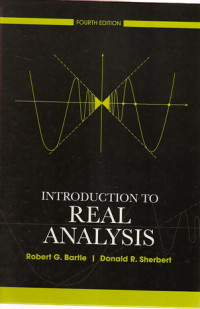Text
Introduction to real analysis
The study of real analysis is indispensable for a prospective graduate student of pure or applied mathematics. It also has great value for any student who wishes to go beyond the routine manipulations of formulas because it develops the ability to think deductively, analyze mathematical situations and extend ideas to new contexts. Mathematics has become valuable in many areas, including economics and management science as well as the physical sciences, engineering, and computer science. This book was written to provide an accessible, reasonably paced treatment of the basic concepts and techniques of real analysis for students in these areas. While students will find this book challenging, experience has demonstrated that serious students are fully capable of mastering the material.
The first three editions were very well received and this edition maintains the same spirit and user-friendly approach as earlier editions. Every section has been examined. Some sections have been revised, new examples and exercises have been added, and a new section on the Darboux approach to the integral has been added to Chapter 7. There is more material than can be covered in a semester and instructors will need to make selections and perhaps use certain topics as honors or extra credit projects.
To provide some help for students in analyzing proofs of theorems, there is an appendix on "Logic and Proofs" that discusses topics such as implications, negations, contrapositives, and different types of proofs. However, it is a more useful experience to learn how to construct proofs by first watching and then doing than by reading about techniques of proof.
Results and proofs are given at a medium level of generality. For instance, continuous functions on closed, bounded intervals are studied in detail, but the proofs can be readily adapted to a more general situation. This approach is used to advantage in Chapter 11 where topological concepts are discussed. There are a large number of examples to illustrate the concepts, and extensive lists of exercises to challenge students and to aid them in understanding the significance of the theorems.
Chapter 1 has a brief summary of the notions and notations for sets and functions that will be used. A discussion of Mathematical Induction is given, since inductive proofs arise frequently. There is also a section on finite, countable and infinite sets. This chapter can used to provide some practice in proofs, or covered quickly, or used as background material and returning later as necessary.
Chapter 2 presents the properties of the real number system. The first two sections deal with Algebraic and Order properties, and the crucial Completeness Property is given in Section 2.3 as the Supremum Property. Its ramifications are discussed throughout the remainder of the chapter.
In Chapter 3, a thorough treatment of sequences is given, along with the associated limit concepts. The material is of the greatest importance. Students find it rather natural though it takes time for them to become accustomed to the use of epsilon. A brief introduction to Infinite Series is given in Section 3.7, with more advanced material presented in Chapter 9.
Ketersediaan
Informasi Detail
- Judul Seri
-
-
- No. Panggil
-
515 Bar i
- Penerbit
- New Jersey : Wiley., 2011
- Deskripsi Fisik
-
xiv, 402 hal. : il. ; 26 cm.
- Bahasa
-
English
- ISBN/ISSN
-
9780471433316
- Klasifikasi
-
515
- Tipe Isi
-
-
- Tipe Media
-
-
- Tipe Pembawa
-
-
- Edisi
-
Ed. IV
- Subjek
- Info Detail Spesifik
-
-
- Pernyataan Tanggungjawab
-
-
Versi lain/terkait
Tidak tersedia versi lain
Lampiran Berkas
Komentar
Anda harus masuk sebelum memberikan komentar

 Karya Umum
Karya Umum  Filsafat
Filsafat  Agama
Agama  Ilmu-ilmu Sosial
Ilmu-ilmu Sosial  Bahasa
Bahasa  Ilmu-ilmu Murni
Ilmu-ilmu Murni  Ilmu-ilmu Terapan
Ilmu-ilmu Terapan  Kesenian, Hiburan, dan Olahraga
Kesenian, Hiburan, dan Olahraga  Kesusastraan
Kesusastraan  Geografi dan Sejarah
Geografi dan Sejarah